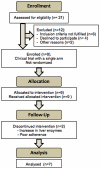Intensification of antiretroviral therapy with a CCR5 antagonist in patients with chronic HIV-1 infection: effect on T cells latently infected
- PMID: 22174752
- PMCID: PMC3234247
- DOI: 10.1371/journal.pone.0027864
Intensification of antiretroviral therapy with a CCR5 antagonist in patients with chronic HIV-1 infection: effect on T cells latently infected
Abstract
Objective: The primary objective was to assess the effect of MVC intensification on latently infected CD4(+) T cells in chronically HIV-1-infected patients receiving antiretroviral therapy.
Methods: We performed an open-label pilot phase II clinical trial involving chronically HIV-1-infected patients receiving stable antiretroviral therapy whose regimen was intensified with 48 weeks of maraviroc therapy. We analyzed the latent reservoir, the residual viremia and episomal 2LTR DNA to examine the relationship between these measures and the HIV-1 latent reservoir, immune activation, lymphocyte subsets (including effector and central memory T cells), and markers associated with bacterial translocation.
Results: Overall a non significant reduction in the size of the latent reservoir was found (p = 0.068). A mean reduction of 1.82 IUPM was observed in 4 patients with detectable latent reservoir at baseline after 48 weeks of intensification. No effect on plasma residual viremia was observed. Unexpectedly, all the patients had detectable 2LTR DNA circles at week 24, while none of them showed those circles at the end of the study. No changes were detected in CD4(+) or CD8(+) counts, although a significant decrease was found in the proportion of HLA-DR(+)/CD38(+) CD4(+) and CD8(+) T-cells. LPS and sCD14 levels increased.
Conclusions: Intensification with MVC was associated with a trend to a decrease in the size of the latent HIV-1 reservoir in memory T cells. No impact on residual viremia was detected. Additional studies with larger samples are needed to confirm the results.
Trial registration: ClinicalTrials.gov NCT00795444.
Conflict of interest statement
Figures






Similar articles
-
Maraviroc Intensification of cART in Patients with Suboptimal Immunological Recovery: A 48-Week, Placebo-Controlled Randomized Trial.PLoS One. 2015 Jul 24;10(7):e0132430. doi: 10.1371/journal.pone.0132430. eCollection 2015. PLoS One. 2015. PMID: 26208341 Free PMC article. Clinical Trial.
-
The effect of intensification with raltegravir on the HIV-1 reservoir of latently infected memory CD4 T cells in suppressed patients.AIDS. 2012 Sep 24;26(15):1885-94. doi: 10.1097/QAD.0b013e3283584521. AIDS. 2012. PMID: 22992577 Clinical Trial.
-
Effect of maraviroc on HIV disease progression-related biomarkers.Antimicrob Agents Chemother. 2012 Nov;56(11):5858-64. doi: 10.1128/AAC.01406-12. Epub 2012 Sep 4. Antimicrob Agents Chemother. 2012. PMID: 22948867 Free PMC article.
-
Clinical utility of maraviroc.Clin Drug Investig. 2011;31(8):527-542. doi: 10.2165/11590700-000000000-00000. Clin Drug Investig. 2011. PMID: 21595497 Review.
-
Maraviroc: a CCR5-receptor antagonist for the treatment of HIV-1 infection.Clin Ther. 2008 Jul;30(7):1228-50. doi: 10.1016/s0149-2918(08)80048-3. Clin Ther. 2008. PMID: 18691983 Review.
Cited by
-
Maraviroc Intensification of cART in Patients with Suboptimal Immunological Recovery: A 48-Week, Placebo-Controlled Randomized Trial.PLoS One. 2015 Jul 24;10(7):e0132430. doi: 10.1371/journal.pone.0132430. eCollection 2015. PLoS One. 2015. PMID: 26208341 Free PMC article. Clinical Trial.
-
Polyanionic carbosilane dendrimers as a new adjuvant in combination with latency reversal agents for HIV treatment.J Nanobiotechnology. 2019 May 21;17(1):69. doi: 10.1186/s12951-019-0500-4. J Nanobiotechnology. 2019. PMID: 31113488 Free PMC article.
-
Differences in HIV Markers between Infected Individuals Treated with Different ART Regimens: Implications for the Persistence of Viral Reservoirs.Viruses. 2020 Apr 27;12(5):489. doi: 10.3390/v12050489. Viruses. 2020. PMID: 32349381 Free PMC article. Review.
-
Effect of the use of Galectin-9 and blockade of TIM-3 receptor in the latent cellular reservoir of HIV-1.J Virol. 2021 Mar 1;95(5):e02214-20. doi: 10.1128/JVI.02214-20. Epub 2020 Dec 23. J Virol. 2021. PMID: 33361434 Free PMC article.
-
Cenicriviroc inhibits trans-endothelial passage of monocytes and is associated with impaired E-selectin expression.J Leukoc Biol. 2018 Dec;104(6):1241-1252. doi: 10.1002/JLB.5A0817-328RRR. Epub 2018 Aug 8. J Leukoc Biol. 2018. PMID: 30088682 Free PMC article.
References
-
- Wong JK, Hezareh M, Gunthard HF, Havlir DV, Ignacio CC, et al. Recovery of replication-competent HIV despite prolonged suppression of plasma viremia. Science. 1997;278:1291–5. - PubMed
-
- Anderson JA, Archin NM, Ince W, Parker D, Wiegand A, et al. Clonal sequences recovered from plasma from patients with residual HIV-1 viremia and on intensified antiretroviral therapy are identical to replicating viral RNAs recovered from circulating resting CD4+ T cells. J Virol. 2011;85:5220–3. - PMC - PubMed
Publication types
MeSH terms
Substances
Associated data
LinkOut - more resources
Full Text Sources
Medical
Research Materials

